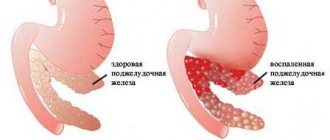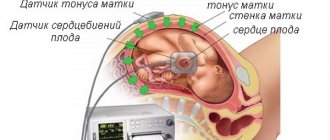Fetus at 36 weeks gestation
The child is actively developing and thoroughly preparing for life in new conditions.
The fruit is already quite big. During his stay in his mother's tummy, he managed to learn a lot. The baby can suck his fingers. This reflex guarantees successful breastfeeding and weight gain. The baby has excellent hearing. It is not surprising if the baby responds to mommy’s sounds with pushes. The baby’s face is already round, and her cheeks are pleasantly full. The baby’s cranial bones are still soft, which is necessary for a less traumatic passage through the birth canal. That's why children are born with slightly deformed skulls. By this time, the child has already grown to 46 cm. And weighs approximately 2700-2800 g. These figures may vary, since each of us has our own heredity.
Signs that not everyone shows
In addition to the signs of impending labor, which appear in most women, there are warning signs that occur only in some mothers. Their appearance depends on the individual characteristics of the pregnant woman and the course of gestation. Such signs of a second birth include changes in the behavior of the woman herself, weight loss, bowel movements, and decreased swelling.
Changes in a pregnant woman's behavior
A few days before giving birth, a hormonal “explosion” occurs in a woman’s body - estrogens begin to be intensively secreted, which affects the behavior of the expectant mother. The woman feels better, her mood rises, and a feeling of euphoria and joy arises. The psycho-emotional state becomes stable and positive.
There is a desire to furnish your apartment, especially the room of your future baby. The pregnant woman begins to do general cleaning, rearrangement, and completes the work she started. Perinatal psychologists and obstetricians call this behavior the nesting instinct. Anticipating the imminent birth of the baby, the mother tries to arrange her “nest”.
Purgation
2-3 days before birth, the stomach drops, the uterus presses on the bladder and intestines (more details in the article: how to understand that the stomach has dropped before childbirth in multiparous women?). In some women, the body reacts to this change with diarrhea. Before childbirth, stool becomes loose and frequent, and the pregnant woman has to visit the toilet several times a day. Other gastrointestinal disorders also occur: nausea, vomiting. The woman refuses to eat; any food causes a gag reflex. Many people mistake this condition for food poisoning, but such disruptions in the digestive system can also be a harbinger of childbirth.
However, not everyone experiences this symptom of the onset of labor. Sometimes uterine prolapse leads to constipation (the woman is offered an enema) or does not in any way affect the nature of the stool.
Weight loss, swelling reduction
At 37–38 weeks, the expectant mother notices that weight gain stops or body weight decreases. Excess fluid is removed from the body. Normally, a woman loses only 1–2 kg.
By getting rid of excess fluid, swelling is reduced. The face, limbs, especially legs, stop swelling, and it becomes easier to move.
What's happening to mom?
What happens to the mother at 38 weeks of pregnancy? Her belly is already too big and causes a lot of discomfort. It is located much lower than before. It is impossible to stand on your feet for a long time, they swell and there is a tingling sensation. At night it is difficult to find a comfortable sleeping position.
The body begins to prepare for the birth of a child. The uterus descends, and as a result, the woman’s heartburn and stomach discomfort finally disappear completely. A pregnant woman can enjoy eating, and breathing also becomes easier. But in addition, this provokes frequent trips to the toilet; the fetus in the uterus puts a lot of pressure on the bladder. Therefore, swelling at 38 weeks is normal. Constipation may occur. Because at the same time the baby puts pressure on the rectum and does not allow feces to pass normally.
Pregnant women notice significant breast enlargement, and many already have colostrum at this stage. It is important that the bra does not cause discomfort. You should not buy a lot of them, since after childbirth the breasts still increase in size. In first-time mothers, the increase may double on the second or third day after the birth of the baby.
During a visual examination, the doctor notes shortening of the cervix. She becomes softer. If labor has not yet begun, then the mucus in the vagina is without foreign impurities. At this time, the pelvic bones actively move apart, and the joints become more mobile.
The child is no longer so active, since he has very little space. But if the mother does not feel the baby moving for a long time, this is a reason to sound the alarm and go to the hospital. The position he occupies (upside down or sitting on his butt) remains until childbirth. Therefore, if the presentation of the fetus is incorrect, then already at this stage the doctor warns about a possible caesarean section.
Recommendations for 36 weeks
Long walks are needed to absorb more oxygen. A child needs protein, so foods rich in this substance should be included in the diet.
Vitamins and minerals for pregnant women will also be beneficial; long walks should be alternated with proper rest. Now a pregnant woman’s blood pressure may jump a little. These surges may also be caused by the emotional situation at home.
Therefore, it is important to support the pregnant woman and protect her from negativity. But even if labor begins, the baby will not be recognized as premature
Once in the maternity hospital, when the 36th week of pregnancy has already arrived, you will have to answer many questions. For example, whether you are bleeding, how often contractions occur and how long they last. You will even have to remember what you ate and when it was.
The ideal option is if you meet the doctor who will deliver your baby before the 36th week of pregnancy arrives.
It is important to agree on some nuances related to childbirth itself.
You have the right to insist on your own, even if this is not practiced in the maternity hospital you have chosen. For example, all procedures necessary for the baby are recommended to be carried out after the child’s seat is released. It is recommended to cut the umbilical cord not immediately, but after its pulsation stops. It is advisable to weigh the baby only after feeding. And the first breastfeeding should take place within half an hour after the baby is born.
Basic actions during childbirth
The first thing you need to do is call an ambulance or use your own transport to get to the maternity hospital. You should only lie on your side. Linen must be washed and ironed
It is important not to lie on the edge of the bed to avoid falling during contractions. Attempts should be measured and cyclical. It is noteworthy that according to statistics, childbirth at 36 weeks is considered the fastest
Reviews from women prove that during this period there are much fewer contractions, and the baby makes its way to the light in just 6-8 hours.
If the doctors are late, and the baby is already asking to go out, under no circumstances should you pull him by the head. The child should only be taken by the shoulders.
Leakage of amniotic fluid
One of the harbingers of the onset of labor is the departure of amniotic fluid. As a rule, this happens during labor, although it happens that the amniotic sac is pierced in the maternity hospital already during childbirth.
During repeated births, the water breaks more often than in first births. This can happen suddenly, often in the middle of the night, the amniotic sac bursts - and water rushes out in a torrent. No pain is felt, but a dull pop may be heard.
The water may also break in parts if the integrity of the amniotic sac is compromised. If the amniotic fluid has passed, but there are no contractions yet, then you should go to the maternity hospital immediately.
Methods for artificially inducing contractions
Traditional methods of inducing labor
- Sex is the world-famous and most recommended method of artificially stimulating contractions. Experts, gynecologists and even women have noted the effectiveness of this method from their own experience. During lovemaking, you cannot use protection; it is the sperm that will cause the uterus to contract and stimulate the desired process. Precursors of labor in multiparous women will not appear at week 40, but real contractions may begin.
Stimulating the nipples will release oxytocin into the body, a hormone that stimulates labor. The nipples should be stimulated very carefully so as not to injure them.
Increasing physical activity can also lead to the baby coming into the world faster. This could be special yoga exercises, cleaning or long walks. It is advisable to do all this with one of your relatives, so that if the situation changes and the first signs of labor appear, you can quickly get to the hospital.
Diet and the use of an enema cause contractions of the uterus, after which contractions begin. It is recommended to entrust the administration of the enema to a specialist. Regarding diet, women are advised to eat more fresh fruits and vegetables. Their list necessarily includes parsley, beets, plums, and bananas. The use of castor oil in limited quantities is also acceptable in order to achieve results.
Inhaling aromatic oils will help you stimulate the beginning of the process. The main thing is that there is no allergy or internal rejection to the oils. Scents of jasmine or rose can trigger contractions.
A warm bath is another way to stimulate
The water should be no more than 4 degrees - this is very important. Overheating and sitting in boiling water is not recommended at all!
Medical methods of inducing contractions
If the 42nd week is already coming to an end, some precursors have been present for almost a month, and the baby still does not ask to be born, doctors resort to stimulation with the help of medications. If a girl tried to achieve a natural onset of contractions with the help of advice (hiking, sex, exercise, diet) but nothing worked, then gynecologists consider artificial stimulation. This method is possible only if there are no contraindications.
Medical interventions:
- The introduction of special drugs based on the hormones oxytocin or prostaglandins. They may come in the form of tablets or injections.
- Amniotomy involves puncture of the amniotic sac. The consequence of this manipulation will be a spill of water and the beginning of contractions. Amniotomy is performed using special surgical instruments.
How does repeated childbirth begin and how long does it last?
Obstetricians note that repeated births most often proceed faster than the first. This is the danger, because the rapid passage of the birth canal is fraught with ruptures and birth injuries. However, if the labor process occurs without complications, a quick delivery benefits both mother and baby.
One of the differences between repeat births and first births is that they may be premature. Often, women in labor break their waters already at 38-39 weeks of pregnancy, if this is their second pregnancy (for more details, see the article: precursors of labor in multiparous women at 39 weeks of pregnancy).
Frequency of contractions
Contractions in multiparous women are not much different from contractions in primiparous women. The difference may be in their duration, because the labor process occurs faster: for the first time, this period of labor lasts 12–16 hours, in subsequent periods – 8–10. In addition, in primiparous women, effacement of the cervix precedes the opening of the pharynx, while in multiparous women these processes occur in parallel.
How do contractions begin in multiparous women? Shortly before birth, the pituitary gland begins to produce the hormones prolactin and oxytocin, which cause contraction of the uterine myometrium. Unlike training contractions, true ones occur cyclically, the interval between them gradually becoming smaller. There are three phases of contractions: latent, active and transitional.
The table shows the characteristics of the contraction phases:
| Characteristic | Latent | Active | Transitional |
| Phase duration | 7–8 hours | 3–5 hours | 0.5–1.5 hours |
| Duration of contraction | 20 s. | 20–60 s. | 60 s. |
| Interval | 15 minutes | 2–4 minutes | 2–3 minutes |
| Cervical dilatation | 0–3 cm | 3–7 cm | 7–10 cm |
Pushing period
The main difference between the period of pushing in multiparous and primiparous women is its duration. The process itself is the same, but for the first time it lasts 1–2 hours, later it is reduced and lasts from 20 minutes to 1 hour. This is facilitated by the so-called muscle memory and existing experience. The woman in labor knows how to behave, how to breathe, does not panic, listens to the obstetrician - all this saves her strength and shortens the period of pushing.
Birth of placenta
30-40 minutes after the birth of the baby, uterine contractions begin again, but they are not so intense and are usually painless. The placenta and membranes come out. After the birth of the placenta, the birth is considered over.
How quickly does labor occur in multiparous women? Women give birth faster the second time around. On average, the duration of labor from the onset of contractions to the birth of the placenta is 9–11 hours. If the baby was born within 4 hours, obstetricians talk about a quick birth. A labor process lasting less than 2 hours is called rapid labor and is accompanied by high trauma. The woman will need a long postpartum recovery.
READ ALSO: On what day after birth does milk appear in multiparous women?
Why does the lower abdomen feel tight? Possible reasons
Why does the lower abdomen feel tight at 38 weeks of pregnancy? During this period, a woman often experiences discomfort and pain in this area. This scares many people and gives them reason to worry whether everything is okay with the baby. Some even confuse them with contractions and the onset of labor. Below is a look at what causes pain and when you should worry.
Causes of pain in the lower abdomen:
- The baby at this stage already weighs quite a bit (about 3 kg), and the placenta also weighs up to 2 kg. And all this weight puts pressure on the organs located below the uterus. That’s why the lower abdomen pulls at 38 weeks of pregnancy;
- The process of separation of the pelvic bones is quite painful. If childbirth proceeds normally, then the body prepares in advance and the pelvic bones gradually move apart, which causes pain to the woman. Therefore, premature birth is accompanied by more severe pain. The bones should move apart not in two weeks, but in two hours;
- also pulls in the lower abdomen at 38 weeks of pregnancy due to the fact that the baby compresses the nerve endings and blood vessels, thereby causing pain;
- a lack of vitamins in the body can also cause pain;
- these could be false contractions, to make sure that the contractions are false, you need to walk around the apartment, sit, lie down. They retreat from this. But if this does not help and the frequency of pain becomes more frequent, then the moment of childbirth has arrived;
- drooping of the abdomen occurs shortly before childbirth and also causes pain.
But if the pain is accompanied by additional symptoms (deterioration in health; spotting; the child has stopped moving, and so on), then you need to immediately go to the hospital to save the baby’s life.
Stool disorders
An extremely unpleasant, but no less common precursor to childbirth in multiparous women. Usually a woman begins to go to the toilet very often. In multiparous women, as a rule, such changes in the functioning of the gastrointestinal tract indicate that childbirth will occur in the next few days or even earlier.
In addition to diarrhea, a woman may experience nausea, sometimes with severe vomiting. Often, ignorant women regard such reactions of the body as poisoning and delay contacting a doctor or turn to the completely wrong specialist. Now you know how to act in such situations.
Norms and deviations
A standard pregnancy lasts approximately 280 days. Over 40 weeks means the baby will be post-term. However, a deviation of up to 14 days is considered normal. If labor occurs at 36 weeks of pregnancy, the baby will be premature. However, even such a deviation is permissible. Some women give birth already at the beginning of the third trimester, however, their children grow up healthy and developed.
Childbirth at 36 weeks is normal, both from a physiological and psychological point of view. They do not harm either mother or child. In this case, labor lasts up to 12 hours. The countdown is taken from the first contractions. As a result, the cervix opens. The muscular system then pushes the fetus, placenta and umbilical cord out. It is worth noting that at 36 weeks, premature labor proceeds faster and less painfully, so some impressionable mothers deliberately ask doctors to induce contractions for them earlier. On the other hand, the risk of hemorrhage and complications increases.
In what cases does the stomach not drop before childbirth?
Some women do not experience abdominal prolapse before childbirth for a number of reasons:
- Incorrect position of the fetus (oblique or transverse).
With this pathology, there is no fixation of the fetal head to the pelvic bones, so there are no signs of abdominal prolapse. The belly of such pregnant women has a special shape: it is elongated on the sides.
A significant increase in the amount of amniotic fluid prevents the uterine fundus from descending. In such cases, the baby's head is often not fixed to the pelvic ring. In this pathology, amniotic fluid is not divided into anterior and posterior.
If the child's head exceeds the size of the woman's pelvis, then there is no tight fixation to the bones, as a result of which the head seems to be located above the pelvis, which prevents the prolapse of the abdomen.
- Some fetal diseases.
An enlarged fetal head with hydrocephalus also interferes with its tight fixation to the pelvic bones.
- Incorrect position of the fetal head.
Obstetricians call this category of pathologies “asynclitic insertion,” which means a change in the position of the fetal head.
This happens under the following conditions:
- Extensor positions of the head (frontal, frontoparietal).
Normally, the baby's head is bent, but as the angle between the fetal neck and chin increases, extension states occur. The extreme degree is facial insertion, when the child is presented with his face to the pelvic bones.
- Anteroparietal and posterior parietal asynclitism is a pathology in which the child’s head is inserted when tilted to one side (to the right or to the left).
Asynclitic insertion of the head creates a number of serious complications during childbirth and is often the reason for surgical delivery!
Woman 36 weeks pregnant
By this time, the fundus of the uterus moves up and is located under the chest itself. For this reason, mommy has a very hard time breathing.
The baby moved close to his mother's heart. Courses for future parents are now actively preparing for the upcoming job - the birth of a baby. By this week, almost all pregnant women have decided on the maternity ward where their baby will be born. By this time, dads must also decide whether they will witness the birth of a son or daughter. During pregnancy, a woman experiences a hormonal surge, which causes an increase in hair growth. At 36 weeks, discharge is possible.
The 36th week is the last stage of pregnancy, at which the birth of a baby is considered premature. Childbirth at 37 weeks is already a timely process. In most cases, babies at this stage are positioned head down and only 4% of babies decide to sit on their butts, then doctors talk about the breech presentation of the fetus. In such cases, childbirth will be difficult, and a caesarean section may be prescribed. But a small percentage of women in labor cope quite successfully with this situation without surgery. If you have a pulling sensation in the lower abdomen, you need to see a doctor and diligently follow all his recommendations.
If you are 36 weeks pregnant, signs of labor may include the following:
- lowering of the abdomen;
- training, false uterine contractions;
- discharge of the mucus plug;
- stopping weight gain;
- increased urination and frequent bowel movements;
- mood swings, the appearance of anxiety, tearfulness.
Frequent urination is the most common precursor to childbirth, which is observed in almost all women. The woman in labor is forced to visit the toilet even more often, sometimes every 40 minutes. This also provokes problematic sleep. To ensure a restful night's rest, you should reduce your fluid intake 2 hours before bedtime. Simple gymnastics will also be useful. There is no need to give up homework; feasible physical activity is even beneficial.
At week 36, the woman is already on maternity leave. Mom devotes all her free time to herself and her baby. Now she is worried about purchasing everything necessary for the child and for herself (a nursing bra, for example). It's not too late to sign up for courses for expectant parents.
Many women may still experience late toxicosis this week. Therefore, the doctor now strictly monitors the weight of the pregnant woman. A balance must be maintained in the volumes of liquid consumed and processed.
A pregnant woman's blood volume is approximately 1 liter larger. If an adult has up to 4.5 liters of blood in the body, then a pregnant woman has 5.5 liters. This additional 1 liter is necessary for the life of the fetus.
With toxicosis in the later stages, fluid tends to linger in the body, causing swelling and reducing the rate of blood circulation.
The fetus receives insufficient nutrients and oxygen through the placenta. And this is not good for the baby.
Cramping pain
As you understand, of course, you are unlikely to miss the contractions themselves, or somehow miss them, because you have long imagined what it is. However, even a multiparous woman can easily confuse false or, as doctors say, training contractions with real contractions. Although it should be noted that preparatory or false contractions may well sometimes begin even during the second trimester of pregnancy. You can be absolutely sure that it is time for you to give birth only if contractions are already becoming regular and constantly becoming more frequent, and the intervals between them are becoming shorter. If your painful sensations are constantly getting worse, and literally all your attempts to relax, or lie quietly on your side and sleep, remain completely unsuccessful, know that the contractions of your uterus are constantly continuing, and this can only mean one thing, you will soon see your baby .
It is also possible that brownish or bloody discharge accompanying your contractions can also only indicate the beginning of full labor and the need to wait for the baby in this world. Be prepared: in this case, your birth will occur in a maximum of six or eight hours, and you can’t even doubt it.
Signs of imminent labor in multiparous women
What are the warning signs of labor for multiparous women at 36, 37, 38, 39 and 40 weeks, what can and should the expectant mother pay attention to? What features of the course of pregnancy at this stage are of interest to obstetricians-gynecologists?
Many women know that even with a full-term pregnancy, labor can begin a little earlier. Even 3 weeks before the expected due date based on obstetric gestational age.
And when the 35th or 36th week of pregnancy, the harbingers of labor may already appear in multiparous women. Although, there are women who do not notice them at all. So what are these signs?
1. The level of the fundus of the uterus becomes lower. More typical for the first pregnancy, such signs of labor may be absent in multiparous women. That is, their stomach may drop several hours before giving birth. And sometimes even during childbirth.
During this period, the uterus, which was located in the abdominal cavity during pregnancy, descends into the pelvic area. It becomes easier to breathe and eat, heartburn does not hurt so much, the uterus stops squeezing the lungs and stomach. Less pleasant companions to a lowering abdomen are frequent urination, which has nothing to do with diseases of the urinary system; daily stool can become liquid, which often leads to exacerbation of hemorrhoids, and before childbirth this is especially unpleasant in all respects. This happens because the prolapsed uterus now begins to put pressure on the lower bowel and bladder.
2. Another characteristic symptom of approaching labor is the release of the mucus plug. Normally, the 38th week of pregnancy gives such characteristic harbingers of labor in multiparous women. The cervix is ripening. The body begins to prepare for childbirth by changing its hormonal levels: the hormone progesterone, which maintains pregnancy, is replaced by the hormone estrogen, which softens the cervix and prepares it for the normal course of labor. The cervix, reliably protected by a “plug” of mucus during pregnancy, begins to open slightly, and a small lump of mucus comes out of the vagina. This process is called “removal of the mucus plug.”
Normally, this is a clear, thick mucous discharge, approximately equal in volume to one tablespoon. It may be pinkish or have small streaks of blood. Also, a mucus plug may appear from the vagina in parts over several days.
It is important not to confuse the passage of a mucus plug with bleeding associated with placental abruption. In this case, bright scarlet blood is released, not just streaks in the mucus
3. Harbingers of the onset of labor in multiparous women at 40 weeks are training contractions. They are also called false. But doctors prefer the name - preparatory.
An intelligent organism knows what is coming to it soon and wants to “practice” a little. False contractions may appear during the last week before birth. Training contractions are usually irregular: your stomach may “rock”, as with uterine tone, or contract several times a day for a couple of hours. Don't worry, it's not birth yet.
Labor contractions usually occur 20-25 minutes apart at the very beginning. Moreover, their intensity is constantly increasing. And if you take a couple of antispasmodic tablets, a warm bath, or try to sleep, the spasms will not disappear.
Medical consultation is necessary only in the case of painful and prolonged training contractions that prevent a woman from sleeping and cause severe discomfort. If you just endure them, you can literally run out of steam before giving birth, and then a complication such as weakness of labor is likely to occur - this is an indication for drug stimulation, which is quite painful, and in case of protracted labor and the serious condition of the fetus - an emergency caesarean section.
Inexperienced future parents usually look forward to meeting their baby, and consider that when the 39th week of pregnancy or even the 40th week of pregnancy has already begun, the harbingers of labor are a reason to immediately get ready and go to the maternity hospital. However, normally, such phenomena as the passage of a mucus plug or training contractions are only a sign that everything is in order with the body, the necessary processes of preparation for childbirth are proceeding according to the plan created by nature. Childbirth is already close, but this “close” can take a period of time from several days to a couple of weeks. The main thing in these last weeks is less worry and worry, more pleasant thoughts about a close meeting with the dearest person in your life.
Other possible harbingers of early labor in multiparous women at 37 weeks and later:
- heaviness in the lower abdomen;
- weight loss;
- pain in the pelvis due to its expansion;
- the desire to wash the dishes, tidy up, do repairs, buy more for the baby.
What's happening to the baby?
What happens to the baby at 38 weeks of pregnancy? A child born at this stage is already considered full-term in terms of organ development, weight and height. On average, a child weighs about 3 kg, and the body length is within 50 cm. The child’s skin still has a little vellus hair, and in places (in the folds) there is lubricant. There is subcutaneous fat, the muscles are well developed.
The child is already gaining little, on average - 30 grams per day. The baby's intestines already contain the first feces, which usually come out after birth. If the process of defecation occurs in the womb, then the feces will begin to poison the child. Therefore, doctors make sure that mothers do not overstay their due dates.
The fetus at 38 weeks of gestation is head down in the womb. And if a woman has no health problems, then childbirth will occur naturally. A child makes an average of about 10 movements per day. This is due to the small amount of space in the uterus, and besides, the baby saves energy for delivery. If their number is less, you should go to the hospital.
At this stage, the genitals are fully formed. If at this stage boys do not have testicles descending into the scrotum, then after birth this is done surgically. The lungs are slightly underdeveloped, but the baby is already able to take his first independent breath. The heart is fully developed.
The bones on the head are movably connected so that the child can safely pass through the birth canal. The newborn already has sucking skills, distinguishes colors and can see his mother while feeding. Can focus his gaze. He already has hair on his head and small nails. If a woman is pregnant for the second time, giving birth at 38 weeks of pregnancy is considered normal. Therefore, you can already start preparing for the significant event on the 37th
Recommendations for childbirth
Starting from the 36th week, you can expect the birth of your baby at any second. Therefore, every mother should prepare for childbirth, not only morally, but also literally. In this regard, pregnant women are not recommended to go far from home alone. You should always have a charged phone with you with emergency numbers and relatives.
Childbirth at 36 weeks is common and common. By this time, all the necessary documents and things should already be collected. The first step is to get your passport, medical insurance, phone with charger, slippers, robe, towel. Next, it will not be superfluous to take money, diapers for the baby, cream, powder, spare underwear, wet wipes, dishes and hygiene products. A detailed list of supplies is provided at the place of birth. It is also advisable to bring a hair clip with you so that the hair does not interfere with the first feedings.
Obligatory harbingers of the imminent onset of labor
How do you know when labor begins and where does it start? The obligatory signs of labor during the second pregnancy differ little from the harbingers of the first birth. They do not depend on how many children the woman bore. The severity of these signs may vary, but they will be present in both first-time mothers and those who give birth for the second or third time.
INTERESTING: the main differences between the second birth and the first
Decreased fetal activity
Before birth, the fetus occupies the most convenient position for it. Its size is so large that there is very little space in the uterus. The organ presses from all sides, forcing you to take a compact and most suitable position for birth.
If earlier the baby was actively moving and pushing, then at 36–37 weeks his behavior changes. He calms down and becomes inactive. This indicates his readiness for birth.
Primiparas begin to worry when their baby freezes for several days. However, this is precisely a sign of the norm. Excessive mobility may be a consequence of hypoxia. By the change in the baby's behavior, you can understand that labor will begin in a few days.
Abdominal prolapse and urination patterns
The normal position of the fetus before birth is with the head towards the os of the uterus. At 38 weeks, the baby descends closer to the exit of the womb and rests on the cervix. If the fetus is in the wrong position in the uterus, the woman is sent for a caesarean section.
Abdominal prolapse alleviates the symptoms that tormented the woman in the last weeks of pregnancy:
- shortness of breath decreases;
- heartburn disappears;
- the uterus no longer presses on the diaphragm.
The uterus descends into the pelvic cavity and compresses the organs located in it. First of all, this affects the urinary system. 2–3 days before birth, diuresis changes, the woman experiences a feeling of constant fullness of the bladder, and she has to visit the toilet very often.
Training contractions
Starting from the 20th week, a pregnant woman may experience “false” contractions, or Braxton-Hicks contractions. They do not indicate the approaching or imminent onset of labor; their appearance is associated with contraction of the uterine myometrium.
Training contractions are short-term and last about a minute (more details in the article: when do training contractions begin and how long do they last?). There are large intervals between them, the frequency of false contractions is irregular. A woman’s stomach begins to ache and her lower back begins to ache, like on the first day of her period. Discomfort is easily eliminated by massage, a warm bath and taking antispasmodics. In second-time mothers, false contractions occur later, 1–1.5 months before delivery, and are of less intensity.
Removal of the mucus plug
During pregnancy, the entrance to the uterus is closed by the cervical mucus plug. It is formed under the influence of progesterone, which thickens cervical mucus. The main purpose of the plug is to protect the uterus from infection. Is it possible to recognize the approach of labor by the discharge of cervical mucus?
A few days before the baby is born, the cervix begins to open slightly and the mucous plug comes out. A woman can see it on her underwear, it looks like a lump of transparent mucus. The plug may have a yellowish or cream color; small pink or brownish streaks are also normal (more details in the article: if a pregnant woman’s plug comes off, how long will it take for her to give birth?). Sometimes the mucous clot comes out in parts, and sometimes it appears during childbirth.
Leakage of amniotic fluid
The most important harbinger of labor, by which one can determine its onset, is the rupture of amniotic fluid (we recommend reading: how long will it take for first-time mothers to begin labor if their waters break?). The fluid can literally gush out in a stream - this indicates that the amniotic sac has burst, and you need to urgently go to the maternity hospital. No more than 24 hours should pass between the breaking of the water and the birth of the baby, otherwise this risks oxygen starvation and infection of the fetus.
Sometimes the bladder does not rupture completely, small holes form in it, and amniotic fluid leaks out little by little. This is a dangerous condition - infection can get inside. If you suspect water leakage, you need to do a test or consult a gynecologist.
In multiparous women, 2–6 hours may pass between water breaking and labor. Such harbingers of a second birth indicate that you need to immediately go to the maternity hospital. It happens that labor has already begun, but the amniotic sac has not burst, then it is pierced by an obstetrician (according to indications). A baby can also be born in a bubble - they say about such children “born in a shirt.”
INTERESTING: frequency of contractions before childbirth: when should you go to the maternity hospital?
When is hospitalization necessary?
What happens at 38 weeks of pregnancy that a woman should be hospitalized earlier? During a normal pregnancy, a woman is admitted to the maternity hospital only when contractions begin or when amniotic fluid is released. But things don't always go smoothly.
Under what circumstances can you be admitted to hospital at 38 weeks:
- if bleeding begins, characteristic of placental abruption. This means that the child no longer receives the required amount of nutrients, which have already become scarce due to the aging placenta;
- severely increased blood pressure, swelling and general deterioration of the body. In this case, delivery through cesarean section is necessary;
- If the placenta does not deliver the required amount of oxygen as well as nutrients, the baby begins to starve. This can be detected by ultrasound at 38 weeks of pregnancy, as well as by CTG indicators;
- if the need to stimulate labor is foreseen, then they are admitted to the hospital to prepare for childbirth and stimulate the process;
- during multiple pregnancy. Typically, childbirth occurs at this time, since delivery is performed by cesarean section, it is undesirable to wait for the birth process to begin;
- incorrect presentation of the fetus or it is large. In this case, artificial delivery is recommended. Therefore, the pregnant woman is admitted to the hospital in advance, at 38 weeks.
If the doctor advises to be hospitalized in advance, then it is better to listen to his advice. This way you can avoid the risk of unforeseen situations during childbirth.
Exit of the mucus plug
This harbinger is not observed in all expectant mothers. At the same time, the plug can come out both on the eve of childbirth and several weeks before delivery, appearing almost every day.
Important! Multiparous women experience much faster cervical dilatation compared to primiparous women. Due to this, childbirth can occur even several hours after the plug comes out of the vagina.
The consistency of the cork is slimy, sometimes jelly-like and not the most pleasant to the touch. The color is usually transparent, but can be cream or even brown.
Important! If you find blood in the plug, be sure to notify your doctor. It is also necessary to remember that the plug does not always come out in advance.
In some women, it leaves right during childbirth or along with the amniotic fluid, which is why the expectant mother may not pay attention to this harbinger, simply not noticing it
It is also necessary to remember that the cork does not always come out in advance. In some women, it leaves right during childbirth or along with the amniotic fluid, which is why the expectant mother may not pay attention to this harbinger, simply not noticing it.
What to do if your stomach drops
- First of all, tell your doctor.
- Start preparing an “alarm suitcase” for the maternity hospital.
- Decide on the choice of a maternity facility and a specialist who will conduct the birth.
There are signs that the day the baby will be born is approaching. Most women experience a drooping belly before giving birth. Having entered the third trimester of pregnancy, the mother listens to internal sensations, examines the body in front of the mirror, trying to determine whether the figure has changed or not.
In preparation for birth, the fetus takes a comfortable position and begins to press on the bottom of the uterus. This provokes a lowering of the abdomen before childbirth, and provides the baby with a more comfortable exit.
How much should the belly drop before giving birth?
Towards the end of the second trimester, the fundus of the uterus begins to rest against the chest, and closer to the birth of the child it moves away. By placing her palm under her breast, a woman can independently determine to what level her stomach drops before giving birth. If the brush fits freely, the displacement is 7-8 cm.
Symptoms will tell the expectant mother that her tummy has dropped before giving birth: the pressure on the diaphragm has disappeared, she can breathe easier, and heartburn is not annoying. Unpleasant signs also appeared - it is difficult to choose a position when falling asleep. There was pain in the perineum. More often you want to go to the toilet in a small way, it is more difficult to empty your bowels.
As soon as the child takes the starting position, the movements become less active. The weight changes, after lowering the body weight becomes 3 kg less, the pregnant woman has a duck's gait.
What should the belly look like before childbirth?
- takes on a more elongated, pear-shaped shape;
- becomes hard; the appearance of the abdomen is weighted;
- the navel sticks out.
Pronounced stretch marks form on the skin. The fundus of the uterus has dropped by about 5 cm. The described signs are average; in a number of women, the prolapse is not so noticeable or occurs several hours before delivery.
Harbingers of labor and how to recognize them
Each female body is unique, so it is impossible to say unambiguously on what day the harbingers of childbirth will appear. Experts consider 37-38 weeks to be the beginning of the prenatal period. It is from this moment that the girl begins to feel changes in her body and body.
People around you can also see the harbingers of labor in first-time mothers. The most common is an altered gait.
Signs of labor in multiparous women
Harbingers are a number of symptoms that appear two (one) week before the upcoming event. They indicate the pregnant woman's readiness for childbirth. Most often, firstborns do not notice visible signs or do not pay attention to them
They do not provide a guideline or a clear idea of when exactly an important event will begin
Women who already have children are included in the list of those who give birth prematurely. Especially if the difference between the children is less than three years. Despite this, the harbingers should not be confused with the onset of labor. Signs can appear up to a week in advance and indicate that the body is preparing for an upcoming event.
Having noticed certain changes, a woman should prepare a bag for the maternity hospital and not go to long distances (suburban complexes, etc.).
What exactly do the harbingers of a second birth look like?
- The most obvious sign is a drooping belly. The fetus turns over and is now positioned with its head towards the entrance to the pelvis. This can happen several days before the start of the process.
- Removal of the mucus plug. A clot of brown or yellow mucus will come out of the uterus. This symptom is characterized by painful, pulling sensations in the pelvic area and lower abdomen. The “plug” protects the uterus and fetus from infections throughout pregnancy.
- Training contractions in second-time mothers can go almost unnoticed. This is due to the experience present and the greater readiness of the body. False contractions are not a reason to panic. They can appear at 32 weeks and periodically make themselves felt until the onset of prenatal periods.
- Weight loss is also a precursor to childbirth. A woman noticeably sheds kilograms from 36 weeks, or the numbers on the scale simply stop. This is due to the fact that the future baby has already gained weight. The female body, a couple of weeks before the onset of labor, gets rid of everything unnecessary, swelling in the legs, arms, and face goes away. During this period you can lose up to 3 kilograms. Losing weight does not pose any risks to the fetus or the expectant mother.
- Nesting syndrome occurs in most women. Over the course of a month (at 36-37 weeks), a woman’s hormonal levels stabilize and at this moment she feels a surge of strength. She wants to start general cleaning, rearranging furniture, ironing, getting rid of trash, and so on. All these processes bring untold pleasure to the expectant mother; she anticipates and looks forward to the imminent replenishment.
- Harbingers of imminent labor are the release of colostrum. It is colostrum that is the baby’s first nutrition, so if clear liquid begins to drip from the breast, you should prepare for an early feeding.
- Another harbinger of imminent labor in primiparas and others is a decrease in the number of movements. The reason for the decrease in activity lies in the fact that the baby becomes cramped. The fetus is also preparing for the upcoming event, and therefore conserves its strength - this is the second reason for the decrease in movements.
- Eating disorders and loose stools are also harbingers of the third birth, as well as the first and second. The body is actively cleansed, removing all unnecessary toxins and harmful elements. All efforts will be aimed at ensuring that the baby is born and the process is as easy as possible.
- Change in gait. Due to the different position of the fetus and large belly, girls walk with their backs tilted back. This allows you to not suffer so much from the load on the spine and maintain balance. This precursor is individual and directly depends on the size of the abdomen. If a girl is expecting twins, “proud gait” will definitely be present.
Actions of a pregnant woman after abdominal reduction
Being at home and discovering that the palm passes between the stomach and chest, the pregnant woman does not understand how to behave further. The presence of such a precursor to labor is not a reason for hospitalization in the maternity ward. This means that it is necessary to mobilize strength and prepare for the long-awaited process of the birth of a baby.
After the stomach has become lower, you need to:
- notify the personal obstetrician-gynecologist who will deliver the child;
- collect the necessary things, documents, medicines and care products for the newborn and place them in a visible place;
- plan how the pregnant woman will get to the maternity hospital: leave the car near the house or stock up on the numbers of taxi services, consider the option of calling an ambulance.
You need to remain calm and not panic. In the absence of other precursors of childbirth, there is no point in going to the maternity hospital. It is more correct to wait for the mucus plug to drain or for the amniotic fluid to rupture. If the uterine fundus does not decrease, this is not a pathology. Everything will happen, but at the beginning of the birth act. This development of the process of giving birth to a baby meets the norms. The main thing is that the head enters the birth canal, otherwise surgery cannot be avoided.
The descent of the uterine fundus is a harbinger of labor, indicating the imminent onset of labor. But there is no need to focus your attention and wait impatiently for this moment. Even if the stomach becomes lower right in the delivery room, everything will be within the permitted standard. In the second and subsequent pregnancies, this precursor to labor occurs too close to the birth of the baby.









